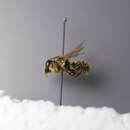Conservation Status
fornecido por University of Alberta Museums
No information indicating any concern.
- licença
- cc-by-nc
- direitos autorais
- University of Alberta Museums
Cyclicity
fornecido por University of Alberta Museums
Flight period mid June - early July, ending late July (Hobbs 1956) - August (Milne & Milne 1980).
- licença
- cc-by-nc
- direitos autorais
- University of Alberta Museums
Distribution
fornecido por University of Alberta Museums
British Columbia, south to California and Mexico and east to Nebraska and Texas. One specimen (male) recorded in Michigan confirms rare range east of Mississippi. Because the females are difficult to distinguish from M. latimanus any specimens found east of Mississippi should only be considered authentic if male specimens are available (Mitchell 1962).
- licença
- cc-by-nc
- direitos autorais
- University of Alberta Museums
General Description
fornecido por University of Alberta Museums
"Females: Identify with caution. Practically undistinguishable from the females of Megachile latimanus Say. Body length is 13-14 mm, stout and completely black with yellowish spurs (articulate hairs). Mouth mandibles have 5 tooth projections. Soft, downy hair (pubescent) is dense and yellow on the lower cheeks, very dense and yellow on lateral and posterior thorax. Abdomen segments are fringed with short whitish hairs. Wings subhyaline (sub transparent) and quite smoky at the apical end. Tergum (dorsal abdomen segment) 6 slightly concave and sternum (ventral abdomen segment) 6 with pollen collecting “scopa” having dense yellowish hairs and scopa is orange in colour. (Mitchell 1962).
Males: Similar to M. latimuanus but recognizable by the mid basitarsal (lower segments of legs) protuberance (swelling) being much smaller, narrow and keel-shaped compared to the blunt, robust protuberance of M. latimuanus. Body length is 12-13 mm, stout, black body with front legs yellowish. Large cheeks with concave inferior margin, nearly twice as wide as the eyes and mouth mandibles with 3-tooth projection. Pubescence is yellowish and is dense and elongate around the antennae, lower face, short and thin on the cheeks with a pair of short white hair (looks like lines). Abdomen segments are fringed with short whitish hairs. Long and bright yellow hairs on the scutum (dorsal surface of middle mesothorax segment). Front tarsi (lower segments on legs) are yellow and mid and hind femur (upper leg segment) are quite swollen. Wings are subhyaline (sub transparent) at the base and appear more cloudy at the apex. Genital armatures have robust gonocoxites, which constricts above the base, setae projects towards the apex, dorsal lobe is broad and flat and ventral lobe is curved and slender. (Mitchell 1962)."
- licença
- cc-by-nc
- direitos autorais
- University of Alberta Museums
Habitat
fornecido por University of Alberta Museums
Nest in ground concealed by dense vegetation (Hobbs 1956). Meadows & orchards (Milne & Milne 1980).
- licença
- cc-by-nc
- direitos autorais
- University of Alberta Museums
Life Cycle
fornecido por University of Alberta Museums
Univoltine (one generation reaches maturity per year) (Hobbs 1956, Milne & Milne 1980). Recorded gregarious nesting in gravel railway embankment (Hobbs 1956). Cells are constructed from circular, oblong or / and irregular leaf cuttings and then provisioned with approximately 15 loads of pollen (Hobbs 1956). Cells are capped off with several circular leaf pieces and are not all constructed in one tunnel (Hobbs 1956). Parasitism by parasitic bees includes Coelioxys spp., meloid beetles (Nemognatha lutea) and red velvet ants (Dasymutilla fulvohirta) (Hobbs 1956, Krombein et al. 1970). Use in agricultural alfalfa pollinating is somewhat limited by the early blooming of alfalfa in Alberta and later flight period of the bee (Hobbs 1956).
- licença
- cc-by-nc
- direitos autorais
- University of Alberta Museums
Trophic Strategy
fornecido por University of Alberta Museums
Polylectic (collects pollen from wide range of flowering plants). Pollen primarily from the family Compositae including Aster and Lotus spp. (Krombein et al. 1970).
- licença
- cc-by-nc
- direitos autorais
- University of Alberta Museums

